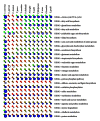Comparative genomics of cryptosporidium
- PMID: 23738321
- PMCID: PMC3659464
- DOI: 10.1155/2013/832756
Comparative genomics of cryptosporidium
Abstract
Until recently, the apicomplexan parasites, Cryptosporidium hominis and C. parvum, were considered the same species. However, the two parasites, now considered distinct species, exhibit significant differences in host range, infectivity, and pathogenicity, and their sequenced genomes exhibit only 95-97% identity. The availability of the complete genome sequences of these organisms provides the potential to identify the genetic variations that are responsible for the phenotypic differences between the two parasites. We compared the genome organization and structure, gene composition, the metabolic and other pathways, and the local sequence identity between the genes of these two Cryptosporidium species. Our observations show that the phenotypic differences between C. hominis and C. parvum are not due to gross genome rearrangements, structural alterations, gene deletions or insertions, metabolic capabilities, or other obvious genomic alterations. Rather, the results indicate that these genomes exhibit a remarkable structural and compositional conservation and suggest that the phenotypic differences observed are due to subtle variations in the sequences of proteins that act at the interface between the parasite and its host.
Figures


References
-
- Fayer R. Cryptosporidium: a water-borne zoonotic parasite. Veterinary Parasitology. 2004;126(1-2):37–56. - PubMed
-
- Leoni F, Amar C, Nichols G, Pedraza Díaz S, McLauchlin J. Genetic analysis of Cryptosporidium from 2414 humans with diarrhoea in England between 1985 and 2000. Journal of Medical Microbiology. 2006;55, part 6:703–707. - PubMed
-
- Hunter PR, Thompson RCA. The zoonotic transmission of Giardia and Cryptosporidium . International Journal for Parasitology. 2005;35(11-12):1181–1190. - PubMed
Grants and funding
LinkOut - more resources
Full Text Sources
Other Literature Sources

